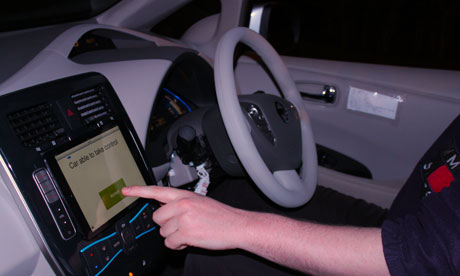New self-driving car system tested on UK roads
February 20, 2013

The self-driving car halts for pedestrians and could take over tedious parts of driving (credit: Oxford University Department of Engineering Science)
Scientists at Oxford University have developed a self-driving car that can cope with snow, rain and other weather conditions. The system can be fitted to existing cars and could one day cost just £100 (US$150), The Guardian reports.
The new system has been installed in a Nissan Leaf electric car and tested on private roads around the university. It will halt for pedestrians, and could take over the tedious parts of driving such as negotiating traffic jams or regular commutes.
The ystem has been demonstrated on public roads — and as long as there is a licensed driver in the driver’s seat, “there’s no obvious legal barrier to using it on roads now,” professor Newman told the Guardian. “It’s essentially an advanced driver assistance system.”
Newman thinks that it could be only 15 years before self-driving systems become commonplace in cities as the price of installing the systems drops: “At present it costs about £5,000, but we’re working to reduce that to £100,” he said.
The car has been tested running at up to 40mph, said Newman.
Rather than using the GPS navigation system, which can be unreliable in cities where “urban canyons” caused by buildings block signals, and only accurate to a few metets, the British-developed system uses 3D laser scanning allied to computer storage to build up a map of its surroundings, which is accurate to a few centimeters.
The auto-drive system works by recognizing where it is, based on a laser scanner on the front of the car, comparing its surroundings to its stored data. That’s different from Google’s system, which uses a combination of GPS, laser guidance — from a roof-mounted laser — and mapping to determine its location and route.
The Oxford system, developed through funding from the Engineering and Physical Sciences Research Council, could be extended so that each car downloads data from passing cars, or over the internet via 3G and 4G connections to a central system.